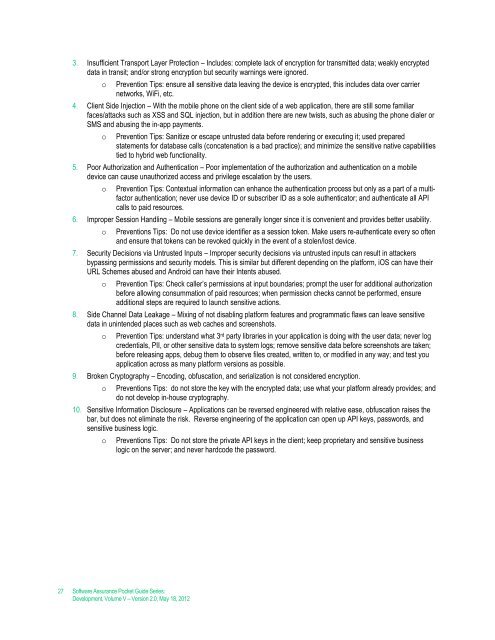Architecture and Design Considerations - Build Security In - US-CERT
Architecture and Design Considerations - Build Security In - US-CERT
Architecture and Design Considerations - Build Security In - US-CERT
You also want an ePaper? Increase the reach of your titles
YUMPU automatically turns print PDFs into web optimized ePapers that Google loves.
3. <strong>In</strong>sufficient Transport Layer Protection – <strong>In</strong>cludes: complete lack of encryption for transmitted data; weakly encrypted<br />
data in transit; <strong>and</strong>/or strong encryption but security warnings were ignored.<br />
o<br />
Prevention Tips: ensure all sensitive data leaving the device is encrypted, this includes data over carrier<br />
networks, WiFi, etc.<br />
4. Client Side <strong>In</strong>jection – With the mobile phone on the client side of a web application, there are still some familiar<br />
faces/attacks such as XSS <strong>and</strong> SQL injection, but in addition there are new twists, such as abusing the phone dialer or<br />
SMS <strong>and</strong> abusing the in-app payments.<br />
o<br />
Prevention Tips: Sanitize or escape untrusted data before rendering or executing it; used prepared<br />
statements for database calls (concatenation is a bad practice); <strong>and</strong> minimize the sensitive native capabilities<br />
tied to hybrid web functionality.<br />
5. Poor Authorization <strong>and</strong> Authentication – Poor implementation of the authorization <strong>and</strong> authentication on a mobile<br />
device can cause unauthorized access <strong>and</strong> privilege escalation by the users.<br />
o<br />
Prevention Tips: Contextual information can enhance the authentication process but only as a part of a multifactor<br />
authentication; never use device ID or subscriber ID as a sole authenticator; <strong>and</strong> authenticate all API<br />
calls to paid resources.<br />
6. Improper Session H<strong>and</strong>ling – Mobile sessions are generally longer since it is convenient <strong>and</strong> provides better usability.<br />
o<br />
Preventions Tips: Do not use device identifier as a session token. Make users re-authenticate every so often<br />
<strong>and</strong> ensure that tokens can be revoked quickly in the event of a stolen/lost device.<br />
7. <strong>Security</strong> Decisions via Untrusted <strong>In</strong>puts – Improper security decisions via untrusted inputs can result in attackers<br />
bypassing permissions <strong>and</strong> security models. This is similar but different depending on the platform, iOS can have their<br />
URL Schemes abused <strong>and</strong> Android can have their <strong>In</strong>tents abused.<br />
o<br />
Prevention Tips: Check caller’s permissions at input boundaries; prompt the user for additional authorization<br />
before allowing consummation of paid resources; when permission checks cannot be performed, ensure<br />
additional steps are required to launch sensitive actions.<br />
8. Side Channel Data Leakage – Mixing of not disabling platform features <strong>and</strong> programmatic flaws can leave sensitive<br />
data in unintended places such as web caches <strong>and</strong> screenshots.<br />
o<br />
Prevention Tips: underst<strong>and</strong> what 3 rd party libraries in your application is doing with the user data; never log<br />
credentials, PII, or other sensitive data to system logs; remove sensitive data before screenshots are taken;<br />
before releasing apps, debug them to observe files created, written to, or modified in any way; <strong>and</strong> test you<br />
application across as many platform versions as possible.<br />
9. Broken Cryptography – Encoding, obfuscation, <strong>and</strong> serialization is not considered encryption.<br />
o<br />
Preventions Tips: do not store the key with the encrypted data; use what your platform already provides; <strong>and</strong><br />
do not develop in-house cryptography.<br />
10. Sensitive <strong>In</strong>formation Disclosure – Applications can be reversed engineered with relative ease, obfuscation raises the<br />
bar, but does not eliminate the risk. Reverse engineering of the application can open up API keys, passwords, <strong>and</strong><br />
sensitive business logic.<br />
o<br />
Preventions Tips: Do not store the private API keys in the client; keep proprietary <strong>and</strong> sensitive business<br />
logic on the server; <strong>and</strong> never hardcode the password.<br />
27 Software Assurance Pocket Guide Series:<br />
Development, Volume V – Version 2.0, May 18, 2012
















